-
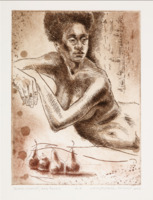 "I document objects, individuals, and places. These subjects (still life, figure and landscape) reflect the foundation of figurative art. I want the images to connect with the viewer through a shared understanding of tactile and perceptual sensibilities."
-Christopher Hickey
"I document objects, individuals, and places. These subjects (still life, figure and landscape) reflect the foundation of figurative art. I want the images to connect with the viewer through a shared understanding of tactile and perceptual sensibilities."
-Christopher Hickey "I document objects, individuals, and places. These subjects (still life, figure and landscape) reflect the foundation of figurative art. I want the images to connect with the viewer through a shared understanding of tactile and perceptual sensibilities."
-Christopher Hickey
-
 The house symbolizes African Americans owning property in the South.
The house symbolizes African Americans owning property in the South. The house symbolizes African Americans owning property in the South.
-
 Edward Ware was the son of Edmund Asa Ware, the first President of Atlanta University. Edward himself was the third President of the University from 1907 to 1919. Prior to this, he attended Yale University and then became Northern Secretary for Atlanta University. He was also a reverend and was appointed Chaplain of the university in 1901. In 1907 he was elected President, and he added classes in industrial arts and education. The University also collaborated with Morehouse College, an African American college, in offering a Business Law and Ethics course during Ware's presidency.
Edward Ware was the son of Edmund Asa Ware, the first President of Atlanta University. Edward himself was the third President of the University from 1907 to 1919. Prior to this, he attended Yale University and then became Northern Secretary for Atlanta University. He was also a reverend and was appointed Chaplain of the university in 1901. In 1907 he was elected President, and he added classes in industrial arts and education. The University also collaborated with Morehouse College, an African American college, in offering a Business Law and Ethics course during Ware's presidency. Edward Ware was the son of Edmund Asa Ware, the first President of Atlanta University. Edward himself was the third President of the University from 1907 to 1919. Prior to this, he attended Yale University and then became Northern Secretary for Atlanta University. He was also a reverend and was appointed Chaplain of the university in 1901. In 1907 he was elected President, and he added classes in industrial arts and education. The University also collaborated with Morehouse College, an African American college, in offering a Business Law and Ethics course during Ware's presidency.
-
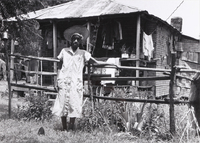 This photograph gives insight into what the South was like during that time. The 1960s were turbulent times for Mississippi. Society was strictly segregated along racial lines, and the social, political, and economic rights of blacks were suppressed through violence and other forms of intimidation.
This photograph gives insight into what the South was like during that time. The 1960s were turbulent times for Mississippi. Society was strictly segregated along racial lines, and the social, political, and economic rights of blacks were suppressed through violence and other forms of intimidation. This photograph gives insight into what the South was like during that time. The 1960s were turbulent times for Mississippi. Society was strictly segregated along racial lines, and the social, political, and economic rights of blacks were suppressed through violence and other forms of intimidation.
-
 The influence of the Civil Rights Movement also found its way into the art annuals, specifically in the last show in 1970, when all of the members of the Jury of Selection were African American—the first time and the last. It is worth noting that the winning assemblage sculpture in the 1970 exhibition was James Newton’s The American Sixties (1969) that, in its minimalistic way, symbolically comments on the rise of black nationalism and civil rights politics of the 1960s. The work features three semi-automatic guns, segmented blocks, and cut out stars all painted in black, with the only color being a thin ribbon of red, white, and blue.
The influence of the Civil Rights Movement also found its way into the art annuals, specifically in the last show in 1970, when all of the members of the Jury of Selection were African American—the first time and the last. It is worth noting that the winning assemblage sculpture in the 1970 exhibition was James Newton’s The American Sixties (1969) that, in its minimalistic way, symbolically comments on the rise of black nationalism and civil rights politics of the 1960s. The work features three semi-automatic guns, segmented blocks, and cut out stars all painted in black, with the only color being a thin ribbon of red, white, and blue. The influence of the Civil Rights Movement also found its way into the art annuals, specifically in the last show in 1970, when all of the members of the Jury of Selection were African American—the first time and the last. It is worth noting that the winning assemblage sculpture in the 1970 exhibition was James Newton’s The American Sixties (1969) that, in its minimalistic way, symbolically comments on the rise of black nationalism and civil rights politics of the 1960s. The work features three semi-automatic guns, segmented blocks, and cut out stars all painted in black, with the only color being a thin ribbon of red, white, and blue.
-
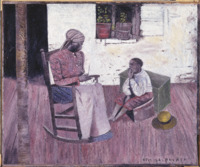 His folk-style realistic oil painting, Let Bygones Be Bygones, won in 1964. The annual exhibition embraced an egalitarian spirit, for both trained artists and self-taught artists could submit artwork to be judged. Also won the first Radio Station WAOK Award.
His folk-style realistic oil painting, Let Bygones Be Bygones, won in 1964. The annual exhibition embraced an egalitarian spirit, for both trained artists and self-taught artists could submit artwork to be judged. Also won the first Radio Station WAOK Award. His folk-style realistic oil painting, Let Bygones Be Bygones, won in 1964. The annual exhibition embraced an egalitarian spirit, for both trained artists and self-taught artists could submit artwork to be judged. Also won the first Radio Station WAOK Award.
-
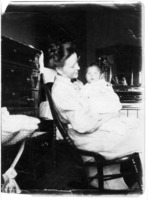 Written on verso: Mrs.Towns and Helen. A woman with a baby. Grace Towns Hamilton Papers
Written on verso: Mrs.Towns and Helen. A woman with a baby. Grace Towns Hamilton Papers Written on verso: Mrs.Towns and Helen. A woman with a baby. Grace Towns Hamilton Papers
-
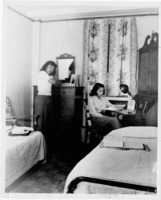 Atlanta University Photographs. Interior of a women's dormitory room with two students.
Atlanta University Photographs. Interior of a women's dormitory room with two students. Atlanta University Photographs. Interior of a women's dormitory room with two students.
-
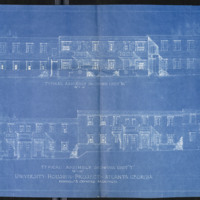 John Hope served as the first African American president of Morehouse College and Atlanta University. The University Homes was the product of his desire to improve the surrounding neighborhoods of the Atlanta University Center.
John Hope served as the first African American president of Morehouse College and Atlanta University. The University Homes was the product of his desire to improve the surrounding neighborhoods of the Atlanta University Center. John Hope served as the first African American president of Morehouse College and Atlanta University. The University Homes was the product of his desire to improve the surrounding neighborhoods of the Atlanta University Center.
-
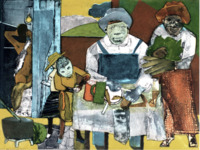 After transitioning from lush abstractions to figurative canvases in the early 1960s, Bearden depicted Black subjects in classical settings and compositions. He combined his flattened figures with intricate patterned dress and semi-abstract, fragmented blocks of color, giving mythological weight to his scenes. He’s most famous for his collages, which he composed from magazines, advertisements, textbooks, and more.
After transitioning from lush abstractions to figurative canvases in the early 1960s, Bearden depicted Black subjects in classical settings and compositions. He combined his flattened figures with intricate patterned dress and semi-abstract, fragmented blocks of color, giving mythological weight to his scenes. He’s most famous for his collages, which he composed from magazines, advertisements, textbooks, and more. After transitioning from lush abstractions to figurative canvases in the early 1960s, Bearden depicted Black subjects in classical settings and compositions. He combined his flattened figures with intricate patterned dress and semi-abstract, fragmented blocks of color, giving mythological weight to his scenes. He’s most famous for his collages, which he composed from magazines, advertisements, textbooks, and more.
-
 This scene of a working-class woman returning to a ramshackle house after a long day's work dramatically expresses the abysmal poverty and bigotry faced by African American Southerners. In the 1930s and '40s, their descendants, exploring their past, rediscovered the South as a place of beauty, strength, vitality, violence, and tradition.
This scene of a working-class woman returning to a ramshackle house after a long day's work dramatically expresses the abysmal poverty and bigotry faced by African American Southerners. In the 1930s and '40s, their descendants, exploring their past, rediscovered the South as a place of beauty, strength, vitality, violence, and tradition.
This scene of a working-class woman returning to a ramshackle house after a long day's work dramatically expresses the abysmal poverty and bigotry faced by African American Southerners. In the 1930s and '40s, their descendants, exploring their past, rediscovered the South as a place of beauty, strength, vitality, violence, and tradition.
-
 The work depicts African American nurses at a Red Cross in a flat, consciously naïve style. When Johnson made the work during the early forties, Knit Your Bit programs held at American Red Cross centers involved the production of hats, scarves, socks, and other winter clothing to support U.S. Armed Forces fighting around the world. It was one of the key ways that Americans at home could support the war effort.
The work depicts African American nurses at a Red Cross in a flat, consciously naïve style. When Johnson made the work during the early forties, Knit Your Bit programs held at American Red Cross centers involved the production of hats, scarves, socks, and other winter clothing to support U.S. Armed Forces fighting around the world. It was one of the key ways that Americans at home could support the war effort. The work depicts African American nurses at a Red Cross in a flat, consciously naïve style. When Johnson made the work during the early forties, Knit Your Bit programs held at American Red Cross centers involved the production of hats, scarves, socks, and other winter clothing to support U.S. Armed Forces fighting around the world. It was one of the key ways that Americans at home could support the war effort.
-
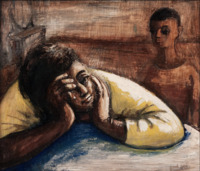 Painted after World War II, it evokes the hardship that faced Americans during the war years when rationing was the norm and many struggled to get necessities
Painted after World War II, it evokes the hardship that faced Americans during the war years when rationing was the norm and many struggled to get necessities Painted after World War II, it evokes the hardship that faced Americans during the war years when rationing was the norm and many struggled to get necessities
-
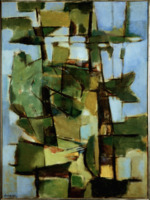 The artist’s methodical brushstrokes suggest that, like Cezanne, he seeks to construct, rather than simply paint, the tree. The work is primarily an exploration of color, spatial planes, and geometry. Yet, it also provides insight into Driskell as an artist comfortable with utilizing abstraction to get to the spiritual essence of things
The artist’s methodical brushstrokes suggest that, like Cezanne, he seeks to construct, rather than simply paint, the tree. The work is primarily an exploration of color, spatial planes, and geometry. Yet, it also provides insight into Driskell as an artist comfortable with utilizing abstraction to get to the spiritual essence of things The artist’s methodical brushstrokes suggest that, like Cezanne, he seeks to construct, rather than simply paint, the tree. The work is primarily an exploration of color, spatial planes, and geometry. Yet, it also provides insight into Driskell as an artist comfortable with utilizing abstraction to get to the spiritual essence of things
-
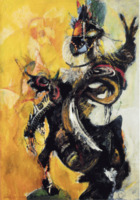 As the larger fine art world continued to celebrate the successes of the abstract expressionist movement in the 1950s, artist like Geraldine McCullough in The Black Knight would harness the language and forms of abstract expressionism in their work, but would not relegate form beneath content. Rather, infused his paintings with the sensibilities and movements grounded in the spirit of African American culture as jazz musicians did in their compositions decades prior.
As the larger fine art world continued to celebrate the successes of the abstract expressionist movement in the 1950s, artist like Geraldine McCullough in The Black Knight would harness the language and forms of abstract expressionism in their work, but would not relegate form beneath content. Rather, infused his paintings with the sensibilities and movements grounded in the spirit of African American culture as jazz musicians did in their compositions decades prior. As the larger fine art world continued to celebrate the successes of the abstract expressionist movement in the 1950s, artist like Geraldine McCullough in The Black Knight would harness the language and forms of abstract expressionism in their work, but would not relegate form beneath content. Rather, infused his paintings with the sensibilities and movements grounded in the spirit of African American culture as jazz musicians did in their compositions decades prior.
-
 Like many writers and artists of his time, Jacob Lawrence was inspired by the dynamic vitality of the Harlem community. In this image, Lawrence depicted a city street teeming with activity. Lawrence used repetition and patterns to create the rhythm of this city scene. Unlike earlier works, in which people and places are portrayed in flat color, in this painting, Lawrence created depth through the use of shadow.
Like many writers and artists of his time, Jacob Lawrence was inspired by the dynamic vitality of the Harlem community. In this image, Lawrence depicted a city street teeming with activity. Lawrence used repetition and patterns to create the rhythm of this city scene. Unlike earlier works, in which people and places are portrayed in flat color, in this painting, Lawrence created depth through the use of shadow. Like many writers and artists of his time, Jacob Lawrence was inspired by the dynamic vitality of the Harlem community. In this image, Lawrence depicted a city street teeming with activity. Lawrence used repetition and patterns to create the rhythm of this city scene. Unlike earlier works, in which people and places are portrayed in flat color, in this painting, Lawrence created depth through the use of shadow.
-
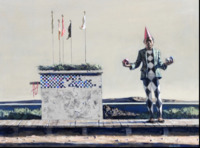 Created in 1972, Hughie Lee-Smith’s painting "The Jester" still resonates as a work that can vividly speak to life in America – a country wrestling with social, economic, and psychological threats previously unfathomed. Lee-Smith’s dunce, however, is no fool. Poised and holding red, white, and blue balls that seem to epitomize the state of the United States, his direct look seems to be a challenge.
Created in 1972, Hughie Lee-Smith’s painting "The Jester" still resonates as a work that can vividly speak to life in America – a country wrestling with social, economic, and psychological threats previously unfathomed. Lee-Smith’s dunce, however, is no fool. Poised and holding red, white, and blue balls that seem to epitomize the state of the United States, his direct look seems to be a challenge. Created in 1972, Hughie Lee-Smith’s painting "The Jester" still resonates as a work that can vividly speak to life in America – a country wrestling with social, economic, and psychological threats previously unfathomed. Lee-Smith’s dunce, however, is no fool. Poised and holding red, white, and blue balls that seem to epitomize the state of the United States, his direct look seems to be a challenge.
-
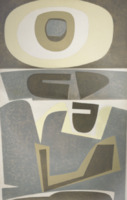 The stark, semi-abstract landscape was inspired by the view of sun, moon and stars reflected across the surface of Lake Superior.
The stark, semi-abstract landscape was inspired by the view of sun, moon and stars reflected across the surface of Lake Superior. The stark, semi-abstract landscape was inspired by the view of sun, moon and stars reflected across the surface of Lake Superior.
-
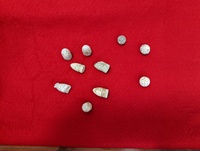 [Untitled]
[Untitled]
-
 Reflects upon the paradoxical relationship between the concept of leisure and African American life
Reflects upon the paradoxical relationship between the concept of leisure and African American life Reflects upon the paradoxical relationship between the concept of leisure and African American life
-
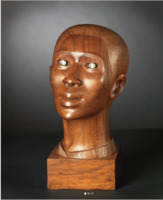 Elizabeth Catlett’s, “Negro Woman” depicts the constant struggle and surprising strength of women, African Americans, those experiencing poverty, and disadvantaged social classes.
Elizabeth Catlett’s, “Negro Woman” depicts the constant struggle and surprising strength of women, African Americans, those experiencing poverty, and disadvantaged social classes. Elizabeth Catlett’s, “Negro Woman” depicts the constant struggle and surprising strength of women, African Americans, those experiencing poverty, and disadvantaged social classes.
-
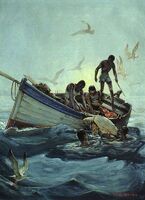 Night Turtle Fishing in Haiti is representative of the type of paintings he composed to counter the representation of black people as caricatures or figures of fun.
Night Turtle Fishing in Haiti is representative of the type of paintings he composed to counter the representation of black people as caricatures or figures of fun. Night Turtle Fishing in Haiti is representative of the type of paintings he composed to counter the representation of black people as caricatures or figures of fun.
-
 [Untitled]
[Untitled]
-
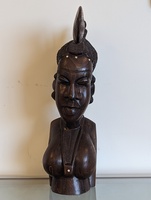 [Untitled]
[Untitled]
-
 [Untitled]
[Untitled]
 "I document objects, individuals, and places. These subjects (still life, figure and landscape) reflect the foundation of figurative art. I want the images to connect with the viewer through a shared understanding of tactile and perceptual sensibilities."
-Christopher Hickey "I document objects, individuals, and places. These subjects (still life, figure and landscape) reflect the foundation of figurative art. I want the images to connect with the viewer through a shared understanding of tactile and perceptual sensibilities." -Christopher Hickey
"I document objects, individuals, and places. These subjects (still life, figure and landscape) reflect the foundation of figurative art. I want the images to connect with the viewer through a shared understanding of tactile and perceptual sensibilities."
-Christopher Hickey "I document objects, individuals, and places. These subjects (still life, figure and landscape) reflect the foundation of figurative art. I want the images to connect with the viewer through a shared understanding of tactile and perceptual sensibilities." -Christopher Hickey The house symbolizes African Americans owning property in the South. The house symbolizes African Americans owning property in the South.
The house symbolizes African Americans owning property in the South. The house symbolizes African Americans owning property in the South. Edward Ware was the son of Edmund Asa Ware, the first President of Atlanta University. Edward himself was the third President of the University from 1907 to 1919. Prior to this, he attended Yale University and then became Northern Secretary for Atlanta University. He was also a reverend and was appointed Chaplain of the university in 1901. In 1907 he was elected President, and he added classes in industrial arts and education. The University also collaborated with Morehouse College, an African American college, in offering a Business Law and Ethics course during Ware's presidency. Edward Ware was the son of Edmund Asa Ware, the first President of Atlanta University. Edward himself was the third President of the University from 1907 to 1919. Prior to this, he attended Yale University and then became Northern Secretary for Atlanta University. He was also a reverend and was appointed Chaplain of the university in 1901. In 1907 he was elected President, and he added classes in industrial arts and education. The University also collaborated with Morehouse College, an African American college, in offering a Business Law and Ethics course during Ware's presidency.
Edward Ware was the son of Edmund Asa Ware, the first President of Atlanta University. Edward himself was the third President of the University from 1907 to 1919. Prior to this, he attended Yale University and then became Northern Secretary for Atlanta University. He was also a reverend and was appointed Chaplain of the university in 1901. In 1907 he was elected President, and he added classes in industrial arts and education. The University also collaborated with Morehouse College, an African American college, in offering a Business Law and Ethics course during Ware's presidency. Edward Ware was the son of Edmund Asa Ware, the first President of Atlanta University. Edward himself was the third President of the University from 1907 to 1919. Prior to this, he attended Yale University and then became Northern Secretary for Atlanta University. He was also a reverend and was appointed Chaplain of the university in 1901. In 1907 he was elected President, and he added classes in industrial arts and education. The University also collaborated with Morehouse College, an African American college, in offering a Business Law and Ethics course during Ware's presidency. This photograph gives insight into what the South was like during that time. The 1960s were turbulent times for Mississippi. Society was strictly segregated along racial lines, and the social, political, and economic rights of blacks were suppressed through violence and other forms of intimidation. This photograph gives insight into what the South was like during that time. The 1960s were turbulent times for Mississippi. Society was strictly segregated along racial lines, and the social, political, and economic rights of blacks were suppressed through violence and other forms of intimidation.
This photograph gives insight into what the South was like during that time. The 1960s were turbulent times for Mississippi. Society was strictly segregated along racial lines, and the social, political, and economic rights of blacks were suppressed through violence and other forms of intimidation. This photograph gives insight into what the South was like during that time. The 1960s were turbulent times for Mississippi. Society was strictly segregated along racial lines, and the social, political, and economic rights of blacks were suppressed through violence and other forms of intimidation. The influence of the Civil Rights Movement also found its way into the art annuals, specifically in the last show in 1970, when all of the members of the Jury of Selection were African American—the first time and the last. It is worth noting that the winning assemblage sculpture in the 1970 exhibition was James Newton’s The American Sixties (1969) that, in its minimalistic way, symbolically comments on the rise of black nationalism and civil rights politics of the 1960s. The work features three semi-automatic guns, segmented blocks, and cut out stars all painted in black, with the only color being a thin ribbon of red, white, and blue. The influence of the Civil Rights Movement also found its way into the art annuals, specifically in the last show in 1970, when all of the members of the Jury of Selection were African American—the first time and the last. It is worth noting that the winning assemblage sculpture in the 1970 exhibition was James Newton’s The American Sixties (1969) that, in its minimalistic way, symbolically comments on the rise of black nationalism and civil rights politics of the 1960s. The work features three semi-automatic guns, segmented blocks, and cut out stars all painted in black, with the only color being a thin ribbon of red, white, and blue.
The influence of the Civil Rights Movement also found its way into the art annuals, specifically in the last show in 1970, when all of the members of the Jury of Selection were African American—the first time and the last. It is worth noting that the winning assemblage sculpture in the 1970 exhibition was James Newton’s The American Sixties (1969) that, in its minimalistic way, symbolically comments on the rise of black nationalism and civil rights politics of the 1960s. The work features three semi-automatic guns, segmented blocks, and cut out stars all painted in black, with the only color being a thin ribbon of red, white, and blue. The influence of the Civil Rights Movement also found its way into the art annuals, specifically in the last show in 1970, when all of the members of the Jury of Selection were African American—the first time and the last. It is worth noting that the winning assemblage sculpture in the 1970 exhibition was James Newton’s The American Sixties (1969) that, in its minimalistic way, symbolically comments on the rise of black nationalism and civil rights politics of the 1960s. The work features three semi-automatic guns, segmented blocks, and cut out stars all painted in black, with the only color being a thin ribbon of red, white, and blue. His folk-style realistic oil painting, Let Bygones Be Bygones, won in 1964. The annual exhibition embraced an egalitarian spirit, for both trained artists and self-taught artists could submit artwork to be judged. Also won the first Radio Station WAOK Award. His folk-style realistic oil painting, Let Bygones Be Bygones, won in 1964. The annual exhibition embraced an egalitarian spirit, for both trained artists and self-taught artists could submit artwork to be judged. Also won the first Radio Station WAOK Award.
His folk-style realistic oil painting, Let Bygones Be Bygones, won in 1964. The annual exhibition embraced an egalitarian spirit, for both trained artists and self-taught artists could submit artwork to be judged. Also won the first Radio Station WAOK Award. His folk-style realistic oil painting, Let Bygones Be Bygones, won in 1964. The annual exhibition embraced an egalitarian spirit, for both trained artists and self-taught artists could submit artwork to be judged. Also won the first Radio Station WAOK Award. Written on verso: Mrs.Towns and Helen. A woman with a baby. Grace Towns Hamilton Papers Written on verso: Mrs.Towns and Helen. A woman with a baby. Grace Towns Hamilton Papers
Written on verso: Mrs.Towns and Helen. A woman with a baby. Grace Towns Hamilton Papers Written on verso: Mrs.Towns and Helen. A woman with a baby. Grace Towns Hamilton Papers Atlanta University Photographs. Interior of a women's dormitory room with two students. Atlanta University Photographs. Interior of a women's dormitory room with two students.
Atlanta University Photographs. Interior of a women's dormitory room with two students. Atlanta University Photographs. Interior of a women's dormitory room with two students. John Hope served as the first African American president of Morehouse College and Atlanta University. The University Homes was the product of his desire to improve the surrounding neighborhoods of the Atlanta University Center. John Hope served as the first African American president of Morehouse College and Atlanta University. The University Homes was the product of his desire to improve the surrounding neighborhoods of the Atlanta University Center.
John Hope served as the first African American president of Morehouse College and Atlanta University. The University Homes was the product of his desire to improve the surrounding neighborhoods of the Atlanta University Center. John Hope served as the first African American president of Morehouse College and Atlanta University. The University Homes was the product of his desire to improve the surrounding neighborhoods of the Atlanta University Center. After transitioning from lush abstractions to figurative canvases in the early 1960s, Bearden depicted Black subjects in classical settings and compositions. He combined his flattened figures with intricate patterned dress and semi-abstract, fragmented blocks of color, giving mythological weight to his scenes. He’s most famous for his collages, which he composed from magazines, advertisements, textbooks, and more. After transitioning from lush abstractions to figurative canvases in the early 1960s, Bearden depicted Black subjects in classical settings and compositions. He combined his flattened figures with intricate patterned dress and semi-abstract, fragmented blocks of color, giving mythological weight to his scenes. He’s most famous for his collages, which he composed from magazines, advertisements, textbooks, and more.
After transitioning from lush abstractions to figurative canvases in the early 1960s, Bearden depicted Black subjects in classical settings and compositions. He combined his flattened figures with intricate patterned dress and semi-abstract, fragmented blocks of color, giving mythological weight to his scenes. He’s most famous for his collages, which he composed from magazines, advertisements, textbooks, and more. After transitioning from lush abstractions to figurative canvases in the early 1960s, Bearden depicted Black subjects in classical settings and compositions. He combined his flattened figures with intricate patterned dress and semi-abstract, fragmented blocks of color, giving mythological weight to his scenes. He’s most famous for his collages, which he composed from magazines, advertisements, textbooks, and more. This scene of a working-class woman returning to a ramshackle house after a long day's work dramatically expresses the abysmal poverty and bigotry faced by African American Southerners. In the 1930s and '40s, their descendants, exploring their past, rediscovered the South as a place of beauty, strength, vitality, violence, and tradition.
This scene of a working-class woman returning to a ramshackle house after a long day's work dramatically expresses the abysmal poverty and bigotry faced by African American Southerners. In the 1930s and '40s, their descendants, exploring their past, rediscovered the South as a place of beauty, strength, vitality, violence, and tradition.
This scene of a working-class woman returning to a ramshackle house after a long day's work dramatically expresses the abysmal poverty and bigotry faced by African American Southerners. In the 1930s and '40s, their descendants, exploring their past, rediscovered the South as a place of beauty, strength, vitality, violence, and tradition.
This scene of a working-class woman returning to a ramshackle house after a long day's work dramatically expresses the abysmal poverty and bigotry faced by African American Southerners. In the 1930s and '40s, their descendants, exploring their past, rediscovered the South as a place of beauty, strength, vitality, violence, and tradition. The work depicts African American nurses at a Red Cross in a flat, consciously naïve style. When Johnson made the work during the early forties, Knit Your Bit programs held at American Red Cross centers involved the production of hats, scarves, socks, and other winter clothing to support U.S. Armed Forces fighting around the world. It was one of the key ways that Americans at home could support the war effort. The work depicts African American nurses at a Red Cross in a flat, consciously naïve style. When Johnson made the work during the early forties, Knit Your Bit programs held at American Red Cross centers involved the production of hats, scarves, socks, and other winter clothing to support U.S. Armed Forces fighting around the world. It was one of the key ways that Americans at home could support the war effort.
The work depicts African American nurses at a Red Cross in a flat, consciously naïve style. When Johnson made the work during the early forties, Knit Your Bit programs held at American Red Cross centers involved the production of hats, scarves, socks, and other winter clothing to support U.S. Armed Forces fighting around the world. It was one of the key ways that Americans at home could support the war effort. The work depicts African American nurses at a Red Cross in a flat, consciously naïve style. When Johnson made the work during the early forties, Knit Your Bit programs held at American Red Cross centers involved the production of hats, scarves, socks, and other winter clothing to support U.S. Armed Forces fighting around the world. It was one of the key ways that Americans at home could support the war effort. Painted after World War II, it evokes the hardship that faced Americans during the war years when rationing was the norm and many struggled to get necessities Painted after World War II, it evokes the hardship that faced Americans during the war years when rationing was the norm and many struggled to get necessities
Painted after World War II, it evokes the hardship that faced Americans during the war years when rationing was the norm and many struggled to get necessities Painted after World War II, it evokes the hardship that faced Americans during the war years when rationing was the norm and many struggled to get necessities The artist’s methodical brushstrokes suggest that, like Cezanne, he seeks to construct, rather than simply paint, the tree. The work is primarily an exploration of color, spatial planes, and geometry. Yet, it also provides insight into Driskell as an artist comfortable with utilizing abstraction to get to the spiritual essence of things The artist’s methodical brushstrokes suggest that, like Cezanne, he seeks to construct, rather than simply paint, the tree. The work is primarily an exploration of color, spatial planes, and geometry. Yet, it also provides insight into Driskell as an artist comfortable with utilizing abstraction to get to the spiritual essence of things
The artist’s methodical brushstrokes suggest that, like Cezanne, he seeks to construct, rather than simply paint, the tree. The work is primarily an exploration of color, spatial planes, and geometry. Yet, it also provides insight into Driskell as an artist comfortable with utilizing abstraction to get to the spiritual essence of things The artist’s methodical brushstrokes suggest that, like Cezanne, he seeks to construct, rather than simply paint, the tree. The work is primarily an exploration of color, spatial planes, and geometry. Yet, it also provides insight into Driskell as an artist comfortable with utilizing abstraction to get to the spiritual essence of things As the larger fine art world continued to celebrate the successes of the abstract expressionist movement in the 1950s, artist like Geraldine McCullough in The Black Knight would harness the language and forms of abstract expressionism in their work, but would not relegate form beneath content. Rather, infused his paintings with the sensibilities and movements grounded in the spirit of African American culture as jazz musicians did in their compositions decades prior. As the larger fine art world continued to celebrate the successes of the abstract expressionist movement in the 1950s, artist like Geraldine McCullough in The Black Knight would harness the language and forms of abstract expressionism in their work, but would not relegate form beneath content. Rather, infused his paintings with the sensibilities and movements grounded in the spirit of African American culture as jazz musicians did in their compositions decades prior.
As the larger fine art world continued to celebrate the successes of the abstract expressionist movement in the 1950s, artist like Geraldine McCullough in The Black Knight would harness the language and forms of abstract expressionism in their work, but would not relegate form beneath content. Rather, infused his paintings with the sensibilities and movements grounded in the spirit of African American culture as jazz musicians did in their compositions decades prior. As the larger fine art world continued to celebrate the successes of the abstract expressionist movement in the 1950s, artist like Geraldine McCullough in The Black Knight would harness the language and forms of abstract expressionism in their work, but would not relegate form beneath content. Rather, infused his paintings with the sensibilities and movements grounded in the spirit of African American culture as jazz musicians did in their compositions decades prior. Like many writers and artists of his time, Jacob Lawrence was inspired by the dynamic vitality of the Harlem community. In this image, Lawrence depicted a city street teeming with activity. Lawrence used repetition and patterns to create the rhythm of this city scene. Unlike earlier works, in which people and places are portrayed in flat color, in this painting, Lawrence created depth through the use of shadow. Like many writers and artists of his time, Jacob Lawrence was inspired by the dynamic vitality of the Harlem community. In this image, Lawrence depicted a city street teeming with activity. Lawrence used repetition and patterns to create the rhythm of this city scene. Unlike earlier works, in which people and places are portrayed in flat color, in this painting, Lawrence created depth through the use of shadow.
Like many writers and artists of his time, Jacob Lawrence was inspired by the dynamic vitality of the Harlem community. In this image, Lawrence depicted a city street teeming with activity. Lawrence used repetition and patterns to create the rhythm of this city scene. Unlike earlier works, in which people and places are portrayed in flat color, in this painting, Lawrence created depth through the use of shadow. Like many writers and artists of his time, Jacob Lawrence was inspired by the dynamic vitality of the Harlem community. In this image, Lawrence depicted a city street teeming with activity. Lawrence used repetition and patterns to create the rhythm of this city scene. Unlike earlier works, in which people and places are portrayed in flat color, in this painting, Lawrence created depth through the use of shadow. Created in 1972, Hughie Lee-Smith’s painting "The Jester" still resonates as a work that can vividly speak to life in America – a country wrestling with social, economic, and psychological threats previously unfathomed. Lee-Smith’s dunce, however, is no fool. Poised and holding red, white, and blue balls that seem to epitomize the state of the United States, his direct look seems to be a challenge. Created in 1972, Hughie Lee-Smith’s painting "The Jester" still resonates as a work that can vividly speak to life in America – a country wrestling with social, economic, and psychological threats previously unfathomed. Lee-Smith’s dunce, however, is no fool. Poised and holding red, white, and blue balls that seem to epitomize the state of the United States, his direct look seems to be a challenge.
Created in 1972, Hughie Lee-Smith’s painting "The Jester" still resonates as a work that can vividly speak to life in America – a country wrestling with social, economic, and psychological threats previously unfathomed. Lee-Smith’s dunce, however, is no fool. Poised and holding red, white, and blue balls that seem to epitomize the state of the United States, his direct look seems to be a challenge. Created in 1972, Hughie Lee-Smith’s painting "The Jester" still resonates as a work that can vividly speak to life in America – a country wrestling with social, economic, and psychological threats previously unfathomed. Lee-Smith’s dunce, however, is no fool. Poised and holding red, white, and blue balls that seem to epitomize the state of the United States, his direct look seems to be a challenge. The stark, semi-abstract landscape was inspired by the view of sun, moon and stars reflected across the surface of Lake Superior. The stark, semi-abstract landscape was inspired by the view of sun, moon and stars reflected across the surface of Lake Superior.
The stark, semi-abstract landscape was inspired by the view of sun, moon and stars reflected across the surface of Lake Superior. The stark, semi-abstract landscape was inspired by the view of sun, moon and stars reflected across the surface of Lake Superior. [Untitled]
[Untitled]  Reflects upon the paradoxical relationship between the concept of leisure and African American life Reflects upon the paradoxical relationship between the concept of leisure and African American life
Reflects upon the paradoxical relationship between the concept of leisure and African American life Reflects upon the paradoxical relationship between the concept of leisure and African American life Elizabeth Catlett’s, “Negro Woman” depicts the constant struggle and surprising strength of women, African Americans, those experiencing poverty, and disadvantaged social classes. Elizabeth Catlett’s, “Negro Woman” depicts the constant struggle and surprising strength of women, African Americans, those experiencing poverty, and disadvantaged social classes.
Elizabeth Catlett’s, “Negro Woman” depicts the constant struggle and surprising strength of women, African Americans, those experiencing poverty, and disadvantaged social classes. Elizabeth Catlett’s, “Negro Woman” depicts the constant struggle and surprising strength of women, African Americans, those experiencing poverty, and disadvantaged social classes. Night Turtle Fishing in Haiti is representative of the type of paintings he composed to counter the representation of black people as caricatures or figures of fun. Night Turtle Fishing in Haiti is representative of the type of paintings he composed to counter the representation of black people as caricatures or figures of fun.
Night Turtle Fishing in Haiti is representative of the type of paintings he composed to counter the representation of black people as caricatures or figures of fun. Night Turtle Fishing in Haiti is representative of the type of paintings he composed to counter the representation of black people as caricatures or figures of fun. [Untitled]
[Untitled]  [Untitled]
[Untitled]  [Untitled]
[Untitled]